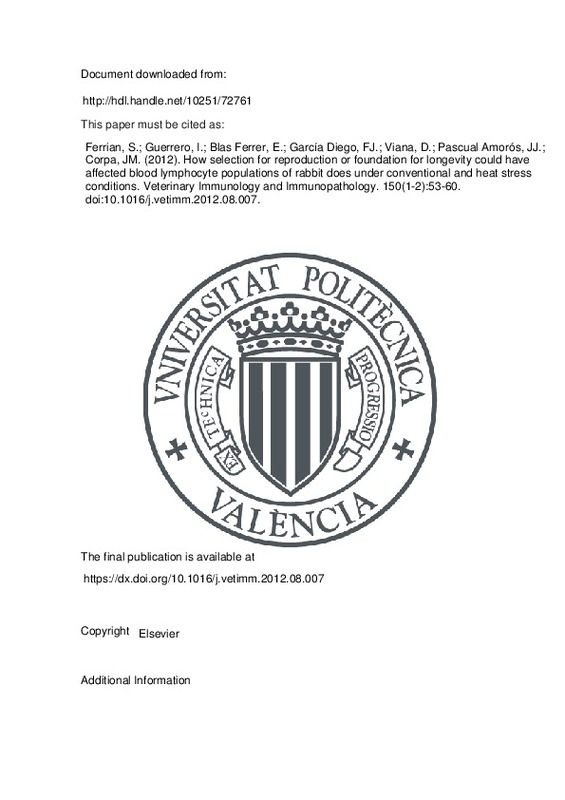|
Resumen:
|
[EN] The present work characterises how selection for reproduction (by comparing two generations - 16th and 36th - of the V line selected for litter size at weaning) or foundation for reproductive longevity (the LP line) ...[+]
[EN] The present work characterises how selection for reproduction (by comparing two generations - 16th and 36th - of the V line selected for litter size at weaning) or foundation for reproductive longevity (the LP line) can affect the blood lymphocytes populations of reproductive rabbit does under normal [conventional housing, average daily minimum and maximum temperatures of 14 degrees C and 20 degrees C, respectively] and heat stress conditions [climatic chamber, 25 degrees C and 36 degrees C] from the first to the second parturition. Housing under heat stress conditions significantly reduced the B lymphocytes counts in female rabbits (-34 x 10(6)/L; P < 0.05). The highest lymphocytes population value in blood (total, T CD5(+), CD4(+) and CD8(+)) was noted at the first parturition, while the B lymphocytes count was significantly lower at the second parturition (-61 x 10(6)/L; P < 0.05). Selection for litter size at weaning (V females) reduced the average counts of total and B lymphocytes in blood (-502 and -60 x 10(6)/L, respectively; P < 0.01), mainly because these populations in V36 females continuously lowered from the first to the second parturition under normal housing conditions. Thus, more selected females (V36) at the second parturition showed significantly lower counts in blood for total, T CD5(+) and CD25(+) lymphocytes (-1303, -446 and -33 x 10(6)/L, respectively; P < 0.05). The main differences in blood counts between V36 and V16 females disappeared when housed under heat stress conditions, except for T CD5(+) and CD25(+), which significantly increased (T CD5(+): +428 x 10(6)/L; CD25(+): +41 x 10(6)/L; P < 0.01) in the V16 vs. V36 females on day 10 post-partum. Under normal conditions, no differences between LP and V36 females were found for most lymphocyte populations; only higher counts were noted in CD25(+) (+20 x 10(6)/L; P < 0.05) for LP females. However, the lymphocytes counts [especially total (+1327 x 10(6)/L; P < 0.01) and T CD5(+) (+376 x 10(6)/L; P < 0.10)] of LP females increased under heat vs. normal conditions when lymphocytes populations presented the lowest values (second parturition), while V36 females' counts remained invariable. Positive correlations were found between feed intake (r = +0.51; P < 0.001) and females' perirenal fat thickness (r = +0.40; P < 0.001) with B lymphocytes counts in the blood of primiparous rabbit females in the week 2 of lactation. These results indicate that selection for litter size at weaning might diminish their immune system's response and adaptation capacity, while the foundation for reproductive longevity criteria leads to more robust rabbit females as they present greater modulation under heat stress conditions when the immune system is affected. (c) 2012 Elsevier B.V. All rights reserved.
[-]
|
|
Agradecimientos:
|
This study has been supported by grants from the CEU-Cardenal Herrera University (Banco Santander/CEU-UCH: Copernicus Program), Generalitat Valenciana (ACOMP/2009/207 and ACOMP/2010/062) and the Comision Interministerial ...[+]
This study has been supported by grants from the CEU-Cardenal Herrera University (Banco Santander/CEU-UCH: Copernicus Program), Generalitat Valenciana (ACOMP/2009/207 and ACOMP/2010/062) and the Comision Interministerial de Ciencia y Tecnologia (AGL2008-00273/GAN, AGL2008-03274/GAN and AGL2011-30170-CO2-02). Grants for Selena Ferrian and Irene Guerrero from Generalitat Valenciana (the Santiago Grisolia programme) and from the Universidad CEU-Cardenal Herrera, respectively, are also gratefully acknowledged.
[-]
|







![[Cerrado]](/themes/UPV/images/candado.png)


